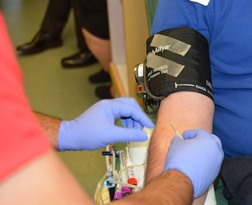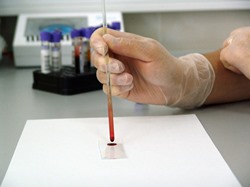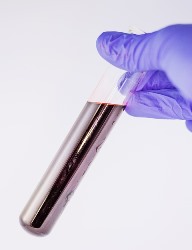Picking a Phlebotomy Technician Training Program near Bertha Minnesota
 Picking the ideal phlebotomy technician training near Bertha MN is a critical initial step toward a rewarding profession as a phlebotomist. It might seem like a daunting task to assess and compare each of the training alternatives that are accessible to you. However it’s necessary that you do your due diligence to ensure that you obtain a quality education. In reality, many potential students start their search by looking at 2 of the qualifiers that first come to mind, which are location and cost. Another factor you might look into is whether to attend classes online or commute to an area campus. We’ll talk a bit more about online schools later in this article. What you need to remember is that there is a lot more to checking out phlebotomy training programs than finding the cheapest or the closest one. Other variables including reputation and accreditation are also important considerations and need to be part of your decision process also. Toward that end, we will provide a list of questions that you need to ask each of the phlebotomy schools you are evaluating to help you select the ideal one for you. But before we do that, let’s cover what a phlebotomist is and does, and afterwards resume our discussion about online classes.
Picking the ideal phlebotomy technician training near Bertha MN is a critical initial step toward a rewarding profession as a phlebotomist. It might seem like a daunting task to assess and compare each of the training alternatives that are accessible to you. However it’s necessary that you do your due diligence to ensure that you obtain a quality education. In reality, many potential students start their search by looking at 2 of the qualifiers that first come to mind, which are location and cost. Another factor you might look into is whether to attend classes online or commute to an area campus. We’ll talk a bit more about online schools later in this article. What you need to remember is that there is a lot more to checking out phlebotomy training programs than finding the cheapest or the closest one. Other variables including reputation and accreditation are also important considerations and need to be part of your decision process also. Toward that end, we will provide a list of questions that you need to ask each of the phlebotomy schools you are evaluating to help you select the ideal one for you. But before we do that, let’s cover what a phlebotomist is and does, and afterwards resume our discussion about online classes.
[campusexplorer header_text=”Find Phlebotomy Schools Near You!” aos=”75346615″ concentration=”E7147EE5″ tracking=”PHL-CT”]
Phlebotomy Technician Job Description
 A phlebotomist, or phlebotomy technician, draws blood from patients. While that is their principal task, there is in fact far more to their job description. Before collecting a blood sample, a phlebotomist needs to check that the instruments being employed are sterile and single use only. After collection, the sample needs to be accurately labeled with the patient’s information. Afterward, paperwork must be correctly completed in order to track the sample from the time of collection through the laboratory screening procedure. The phlebotomist then delivers the blood to either an in-house lab or to an outside lab facility where it may be screened for such things as pregnancy, infectious diseases or blood type. Some Bertha MN phlebotomists in fact work in labs and are responsible for making certain that samples are analyzed properly using the strictest quality assurance procedures. And if those weren’t sufficient responsibilities, they can be called upon to instruct other phlebotomists in the drawing, delivery and follow-up process.
A phlebotomist, or phlebotomy technician, draws blood from patients. While that is their principal task, there is in fact far more to their job description. Before collecting a blood sample, a phlebotomist needs to check that the instruments being employed are sterile and single use only. After collection, the sample needs to be accurately labeled with the patient’s information. Afterward, paperwork must be correctly completed in order to track the sample from the time of collection through the laboratory screening procedure. The phlebotomist then delivers the blood to either an in-house lab or to an outside lab facility where it may be screened for such things as pregnancy, infectious diseases or blood type. Some Bertha MN phlebotomists in fact work in labs and are responsible for making certain that samples are analyzed properly using the strictest quality assurance procedures. And if those weren’t sufficient responsibilities, they can be called upon to instruct other phlebotomists in the drawing, delivery and follow-up process.
Where do Phlebotomists Work?
The simplest response is wherever patients are treated. Their workplaces are numerous and diverse, including Bertha MN hospitals, medical clinics, long-term care facilities, or blood banks. They can be charged to draw blood samples from patients of all ages, from babies or toddlers to seniors. A number of phlebotomy techs, based on their practice and their training, specialize in drawing blood from a certain type of patient. For instance, those practicing in an assisted living facility or nursing home would exclusively be collecting blood from older patients. If they are working in a maternity ward, they would be drawing blood from mothers and newborns exclusively. In contrast, phlebotomists working in a general hospital environment would be drawing blood from a wide range of patients and would work with new patients every day.
Phlebotomist Education, Certification and Licensing
 There are primarily two kinds of programs that provide phlebotomist training in Bertha MN, which are degree and certificate programs. The certificate program typically takes less than a year to finish and offers a basic education together with the training on how to draw blood. It offers the fastest method to becoming a phlebotomy tech. An Associate of Science Degree in Clinical Laboratory Science, even though it’s not specifically a phlebotomy degree, will provide training to become a phlebotomist. Available at junior and community colleges, they usually require 2 years to finish. Bachelor’s Degrees are not as accessible and as a 4 year program provide a more comprehensive foundation in lab sciences. After you have completed your training, you will probably want to get certified. While not required in most states, many employers require certification before employing technicians. A few of the principal certifying agencies include:
There are primarily two kinds of programs that provide phlebotomist training in Bertha MN, which are degree and certificate programs. The certificate program typically takes less than a year to finish and offers a basic education together with the training on how to draw blood. It offers the fastest method to becoming a phlebotomy tech. An Associate of Science Degree in Clinical Laboratory Science, even though it’s not specifically a phlebotomy degree, will provide training to become a phlebotomist. Available at junior and community colleges, they usually require 2 years to finish. Bachelor’s Degrees are not as accessible and as a 4 year program provide a more comprehensive foundation in lab sciences. After you have completed your training, you will probably want to get certified. While not required in most states, many employers require certification before employing technicians. A few of the principal certifying agencies include:
- National Phlebotomy Association
- National Healthcareer Association (NHA)
- American Society for Clinical Pathology (ASCP)
- American Medical Technologists (AMT)
There are several states that do call for certification in order to practice as a phlebotomist, including Nevada and California. California and a handful of other states even require licensing. So it’s important that you enroll in a phlebotomist training program that not only furnishes a quality education, but also prepares you for any certification or licensing examinations that you are required or elect to take.
Phlebotomy Online Training
 First, let’s dispel one potential misconception. You can’t get all of your phlebotomist training online. A substantial part of the program of studies will be clinical training and it will be conducted either in an approved Bertha MN healthcare facility or an on-campus lab|an on-campus lab or an approved healthcare facility}. Numerous courses also require completing an internship prior to graduation. However since the non-practical portion of the training can be attended online, it might be a more practical alternative for some students. As an added benefit, many online classes are less expensive than their traditional competitors. And some expenditures, including those for textbooks or commuting, may be lessened as well. Just make sure that the online phlebotomist school you enroll in is accredited by a national or regional accrediting agency (more on accreditation later). With both the extensive online and clinical training, you can obtain a premium education with this method of learning. If you are disciplined enough to study at home, then attaining your certificate or degree online may be the right choice for you.
First, let’s dispel one potential misconception. You can’t get all of your phlebotomist training online. A substantial part of the program of studies will be clinical training and it will be conducted either in an approved Bertha MN healthcare facility or an on-campus lab|an on-campus lab or an approved healthcare facility}. Numerous courses also require completing an internship prior to graduation. However since the non-practical portion of the training can be attended online, it might be a more practical alternative for some students. As an added benefit, many online classes are less expensive than their traditional competitors. And some expenditures, including those for textbooks or commuting, may be lessened as well. Just make sure that the online phlebotomist school you enroll in is accredited by a national or regional accrediting agency (more on accreditation later). With both the extensive online and clinical training, you can obtain a premium education with this method of learning. If you are disciplined enough to study at home, then attaining your certificate or degree online may be the right choice for you.
Points to Ask Phlebotomist Colleges
Since you now have a basic understanding about what it takes to become a phlebotomy tech, it’s time to begin your due diligence process. You may have already picked the kind of program you wish to enroll in, whether it be for a certificate or a degree. As we previously mentioned, the location of the Minnesota school is relevant in addition to the tuition expense. Maybe you have opted to enroll in an phlebotomy online college. All of these decisions are an important component of the process for picking a program or school. But they are not the only concerns when arriving at your decision. Below we have provided several questions that you need to ask about each of the Bertha MN colleges you are looking at before making your final selection.
Is the Phlebotomist Program State Specific? As mentioned previously, each state has its own laws for practicing as a phlebotomy technician. Some states call for certification, while a few others mandate licensing. Each has its own prerequisite regarding the minimum amount of practical training completed before practicing as a phlebotomist. Consequently, you might need to pass a State Board, licensing or certification examination. Therefore it’s extremely important to enroll in a phlebotomy program that satisfies the state specific requirements for Minnesota or the state where you will be working and preps you for any examinations you may be required to take.
Is the School Accredited? The phlebotomy program and school you pick should be accredited by a recognized regional or national accrediting agency, such as the National Accrediting Agency for Clinical Laboratory Sciences (NAACLS). There are a number of advantages to graduating from an accredited program in addition to an assurance of a premium education. First, if your program has not received accreditation, you will not be able to take a certification examination offered by any of the previously listed certifying agencies. Also, accreditation will help in securing loans or financial assistance, which are often not available for non-accredited colleges in Bertha MN. Finally, graduating from an accredited college can make you more attractive to future employers in the job market.
What is the Program’s Reputation? In many states there is minimal or no regulation of phlebotomist colleges, so there are those that are not of the highest caliber. So along with accreditation, it’s important to investigate the reputations of all colleges you are looking at. You can start by asking the schools for references from employers where they place their graduates as part of their job assistance program. You can research online school rating and review services and ask the accrediting agencies for their reviews as well. You can even check with some Bertha MN local hospitals or clinics that you might have an interest in working for and see if they can offer any recommendations. As a final thought, you can check with the Minnesota school licensing authority and ask if any grievances have been submitted or if the schools are in full compliance.
Is Sufficient Training Provided? To begin with, check with the Minnesota regulator or the state regulator where you will be working to find out if there are any minimum requirements for the amount of training, both classroom and practical. As a minimum, any Bertha MN phlebotomist program that you are considering should furnish no less than 40 hours of classroom training (the majority require 120) and 120 hours of practical training. Anything lower than these minimums may indicate that the program is not comprehensive enough to furnish sufficient training.
Are Internship Programs Sponsored? Ask the Minnesota schools you are considering if they have an internship program in partnership with area medical facilities. They are the ideal means to obtain hands-on clinical training frequently not provided on campus. As an added benefit, internships can assist students establish relationships within the local Bertha MN medical community. And they look good on resumes as well.
Is Job Placement Assistance Available? Landing your first phlebotomist job will be much easier with the support of a job placement program. Inquire if the programs you are looking at offer assistance and what their job placement rate is. If a school has a high rate, signifying they place most of their students in jobs, it’s an indication that the program has both a good reputation along with a large network of professional contacts within the Bertha MN healthcare community.
Are Class Times Offered to Fit Your Schedule? Finally, it’s crucial to confirm that the ultimate program you pick provides classes at times that are compatible with your active schedule. This is particularly important if you decide to still work while going to school. If you can only go to classes in the evenings or on weekends near Bertha MN, make sure they are available at those times. Additionally, if you can only attend on a part-time basis, confirm it is an option also. And if you have decided to study online, with the practical training requirement, make certain those hours can also be fulfilled within your schedule. And find out what the make-up policy is should you need to miss any classes due to illness or emergencies.
Why Did You Want to Be a Phlebotomist?
When prepping to interview for a Phlebotomy Tech position, it's important to reflect on questions you may be asked. One of the things that hiring managers frequently ask Phlebotomy Technician candidates is "What made you decide on Phlebotomy as a career?". What the interviewer is hoping to learn is not merely the personal reasons you might have for becoming Phlebotomist, but additionally what characteristics and abilities you have that make you exceptional at what you do. You will undoubtedly be asked questions pertaining primarily to Phlebotomy, as well as a significant number of typical interview questions, so you must prepare a number of approaches about how you want to answer them. Considering there are several factors that go into choosing a career, you can address this fundamental question in a number of ways. When readying an answer, aim to include the reasons the profession interests you in addition to the talents you possess that make you an outstanding Phlebotomy Technician and the best choice for the position. Don't make an effort to memorize a response, but write down several concepts and anecdotes that relate to your personal strengths and experiences. Reviewing sample responses can help you to prepare your own thoughts, and provide ideas of what to discuss to wow the interviewer.Choose the Ideal Phlebotomy Course near Bertha MN
Making sure that you choose the most suitable phlebotomist training is a critical first step toward your success in this rewarding health care field. As we have discussed in this article, there are several factors that go into the selection of a quality school. Phlebotomist training programs are offered in a wide range of academic institutions, including community or junior colleges, trade schools, and colleges and universities that offer an extensive array of courses in medical care and health sciences. Training program offerings may vary somewhat across the country as each state has its own requirements when it pertains to phlebotomist training, licensing and certification. The most important point is that you must thoroughly evaluate and compare each college before making your final choice. By addressing the questions that we have provided, you will be able to fine tune your options so that you can select the best school for you. And with the appropriate training, you can achieve your goal of becoming a phlebotomy technician in Bertha MN.
Learn About Bertha Minnesota
Bertha, Minnesota
Bertha is a city in Todd County, Minnesota, United States. The population was 497 at the 2010 census.[6]
Bertha was platted in 1891, and named for Bertha Ristan, an early settler.[7] Bertha was incorporated in 1897.[7]
According to the United States Census Bureau, the city has a total area of 1.02 square miles (2.64 km2), all of it land.[1]
As of the census[2] of 2010, there were 497 people, 205 households, and 120 families residing in the city. The population density was 487.3 inhabitants per square mile (188.1/km2). There were 231 housing units at an average density of 226.5 per square mile (87.5/km2). The racial makeup of the city was 99.2% White, 0.2% African American, and 0.6% from two or more races. Hispanic or Latino of any race were 0.2% of the population.
More Interesting Minnesota Cities
Bertha MN Blood Labs - BingNews Search results
-
Mortgage Rates in Minnesota
Terms may apply to offers listed on this page. There are many mortgage lenders serving Minnesota, including banks, credit unions, and online lenders. Buyers purchasing a new home should shop ...
-
Minnesota GOP calls for investigation into District 14B race
One of the closest races, District 14B, was originally reported as a four-vote victory for the GOP. A short time later, the DFL candidate ws shown as the winner by 28 votes. The slim lead has since ...
-
President: general election, Minnesota, 2020
The position of the flag indicates whether the organization is partisan. Organizations are considered partisan if they operate on behalf of a candidate, party, campaign committee, PAC, super PAC, ...
-
Kamala Harris wins Minnesota, CBS News projects
Minnesota's 10 electoral college votes will be going to Democratic Vice President Kamala Harris, CBS News projects. CBS News also projects former President Donald Trump will win the presidency ...
-
UMN lab studies how dead fungi store carbon
University of Minnesota researchers at the College of Biological Sciences Kennedy Lab detail the role dead fungi play in balancing carbon within the soil. The Kennedy Lab studies fungi both dead and ...
-
NOAA's 2024-25 winter forecast is out. Here's what to expect in Minnesota.
The odds slightly favor colder-than-average temperatures, especially in western Minnesota. The amount of precipitation — snow, generally — is likely to be above average during that same stretch.
-
Where Will Rocket Lab Be in 1 Year?
Rocket Lab's Electron is the second-most used orbital rocket in the U.S. Its upcoming Neutron launch vehicle will increase the company's carrying capacity dramatically, and is expected to launch ...
-
The Best Lab-Grown Diamonds, According To A Gem Expert
Even the best lab-grown diamonds can stir up a bit of skepticism in shoppers—and for good reason. You might wonder: How can anything concocted in a laboratory compare to what’s organically ...
-
Special election to decide control of Minnesota Senate
MINNEAPOLIS — If you've been anywhere near Lake Minnetonka lately, you've seen the ubiquitous yard signs for the two women vying for a newly vacated seat in the Minnesota Senate. But the stakes ...
-
State agencies help to rid Minnesota of hidden meth labs
According to the state health department, methamphetamine is the most commonly-made drug in Minnesota labs, and officials discovered approximately 350 such labs in 2001. Besides the obvious dangers of ...

